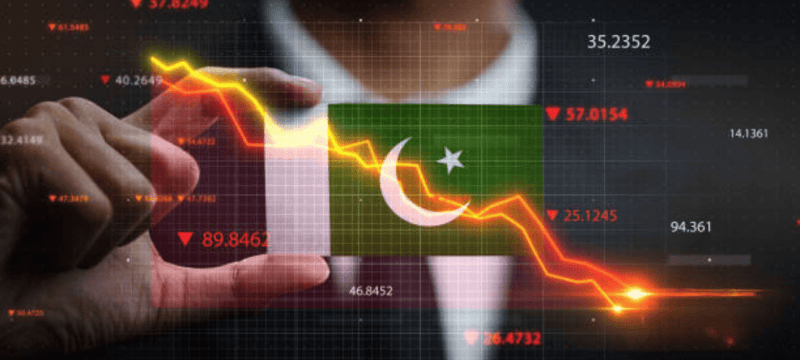Pakistan’s economic growth rate fell to 0.3% in the current fiscal year due to severe import restrictions imposed in an effort to avoid sovereign default, crippling the industrial sector and spilling over into the services sector.
The 0.29% growth rate is the slowest increase in national output in four years, exposing economic mismanagement that is insufficient to meet the needs of 250 million people.
Despite severe flooding, the agricultural sector grew by 1.6%, exceeding all forecasts of contraction due to crop damage. 2.94% of people contacted the industrial sector. However, the services sector, the economy’s single largest sector, grew by 0.9% in nominal terms.
The government has missed all sectoral targets as a result of economic mismanagement, which has also resulted in massive layoffs and contributed to a 59-year high inflation rate of 36.4%.
In a contentious meeting on Wednesday night, the National Accounts Committee approved the provisional Gross Domestic Product (GDP) growth rate for fiscal year 2022-23, which ends on June 30. The meeting was presided over by Planning Secretary Zafar Ali Shah.
Also Read: Saudi Ambassador wants to deepen Pakistan’s economic ties.
The current fiscal year will be remembered in Pakistan as the year when the country experienced devastating floods that washed away crops, a highly mismanaged economy, and a steep drop in people’s purchasing power due to record inflation.
The government has caused significant economic damage by devaluing the rupee and raising utility prices in the hope of obtaining a loan from the International Monetary Fund (IMF). In the end, neither the IMF programme nor the economy could be saved from disaster.
The provisional GDP growth rate for 2022-23 is estimated at 0.29%, according to the Planning Secretary following a meeting of the National Accounts Committee.
According to sources, the government postponed the NAC meeting four times in one week due to disagreement over the increase in national output. According to the sources, some Pakistan Bureau of Statistics officials shuttled from one office to another in order to reach an agreement.
According to Dr Nadeem Javaid, chief economist of the Planning Commission, there is a recession in growth but not an overall recession in the economy.
There was a broad-based drop in economic output, owing primarily to government mismanagement and the negative impact of the floods. The Gross Domestic Product (GDP) is the monetary value of all goods and services produced in a given year.
The nearly 0.3% growth rate was well below the official target of 5% and was consistent with estimates from the Ministry of Finance, the State Bank of Pakistan, the International Monetary Fund, the World Bank, and the Asian Development Bank. All institutions forecasted 0.2% to 0.8% economic growth.
The figure is provisional and subject to change when the final results are released at the end of the fiscal year. The economic growth rate during the last year of the PTI rule was 6%, which the NAC revised to 6.1% on Wednesday.
After initial estimates suggested normal contraction, even the provisional nominal growth rate may become contentious. According to renowned economist Dr. Hafiz Pasha, the economy contracted by more than 3% during the current fiscal year.
The details revealed that massive import and consumption curbs slowed economic growth, triggering a serious external sector crisis – a pattern seen in 2018 when the country fell into the lap of the IMF.
Last year, the Pakistan Tehreek-e-Insaf government ended with a 6.1% growth rate, the highest in four years. The country last achieved 6.1% growth in 2017-18, the final year of the PML-N regime, which was also driven by consumption and imports and sent the country back to the IMF.
Pakistan’s growth was largely financed by foreign savings in 2017-2018 and 2021-2022, which is highly unsustainable. In comparison to the official target of 3.9% growth, the agriculture sector is expected to grow by 1.6%. The increase appears unexpected and could be the result of adding value to around Rs500 billion in flood expenses.
Floods washed away major crops, causing not only food shortages but also the abolition of bread and butter. Agriculture grew 4.3% in the previous fiscal year.
According to PBS Chief Statistician Dr Naeem ul Haq, the agriculture sector grew as a result of better wheat (27.6 million tonnes) and sugarcane (9.1 million tonnes) crops.
The chief statistician denied that he was under any pressure to turn negative growth into positive growth.
The industrial sector shrank by 2.94%, falling short of the 7.4% growth target.The government suffocated industrial growth by imposing import restrictions, resulting in a scarcity of raw materials and, as a result, factory closures. Nonetheless, the contraction appears to be less than a significant slowdown in major industries.
The industrial sector grew 6.8% in the previous fiscal year. In the hope of containing inflation, the State Bank of Pakistan raised interest rates to a record 21%. Nonetheless, the central bank has failed to control inflation, which has already reached 36.4%.
The government had set a 4% growth goal for the services sector. However, preliminary data show that the services sector grew at a 0.9% annual rate. According to the NAC, the services sector grew 6.6% in the previous fiscal year.
The NAC also increased the economic growth rate for the PTI government’s second last year from 6% to 6.1%. The final GDP growth rate for 2020-21 has been revised to 5.8%.




